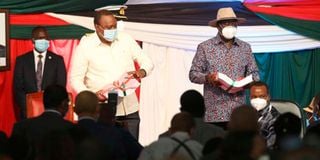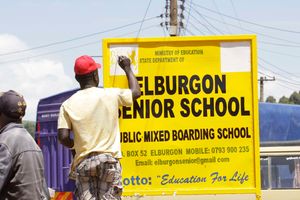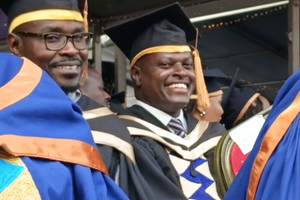Premium
Azimio appeal failed critical test despite array of victories

President Uhuru Kenyatta and former Prime Minister Raila Odinga distribute BBI signing documents to regional representatives at KICC on November 25, 2020 when they launched the collection of signatures.
What you need to know:
- The appeal came at the termination sequence of a domino effect initiated by the Handshake between Kenyatta and Raila Odinga four years ago.
- There is no doubt Odinga and Kenyatta consider themselves the fundamental countervailing variables of Kenya’s political reality in their own right.
Azimio la Umoja’s BBI appeal to the Supreme Court succeeded on four grounds, thus overturning as many adverse findings of the High Court, which had been affirmed by the Court of Appeal, as they likewise nullified the Constitution of Kenya (Amendment) Bill, 2020, for being unconstitutional.
However, the apex court determined the President ineligible to initiate a constitutional amendment by popular initiative, and that President Uhuru Kenyatta did, in fact, initiate such a process through BBI, rendering it unconstitutional. Additionally, the court found that in purporting to create 70 constituencies, the third schedule of the BBI Bill infringed the IEBC’s exclusive constitutional mandate, rendering itself and the Bill unconstitutional.
Besides recognising the President’s immunity from legal action while in office, the appeal chiefly secured an array of phyrric victories that did absolutely nothing to advance the BBI’s essential agenda. The appeal’s failure to rescue the political agenda of the Building Bridges Initiative underscores the magnitude of the tragedy that has befallen the Handshake and the dimensions of the very specific enterprise the BBI was expected to actualise.
As observed by the judges, the appeal came at the termination sequence of a domino effect initiated by the Handshake between Kenyatta and Raila Odinga four years ago. The centrality of these two personages to the BBI affair is of paramount significance, as do the other cardinal dualities that characterise critical dimensions of the undertaking.
To begin with, let us consider the principal actors. There is no doubt Odinga and Kenyatta consider themselves the fundamental countervailing variables of Kenya’s political reality in their own right, and when considered within the framework of their respective political patrimonies. As such, they assume a central political locus exerting immense gravitational force in their domains, and at its core, politics must be understood as the interaction between these phenomena.
Kenyatta is the pivotal nucleus of a broader Kenyatta heritage understood to command a political constituency understood alternately as Jubilee and Mt Kenya, which, ultimately, represents the arch-reactionary, conservative oligarchy. On the other hand, Odinga is the kernel of an Odingaist movement perceived to be the lynchpin, through ODM, of a leftist coalition forged out of a convergence of anti-Establishment energies with the Odingas’ long-standing grievances.
Scions of dynasties
From these vantage points, it is understandable if the latter-day scions of these illustrious dynasties imagine themselves to be the decisive elements of Kenya’s political destiny whose every gesture is necessarily fateful and portentous.
It is also why Kenyatta and Odinga had the temerity to confidently pronounce the Handshake as a private affair, despite expecting it to exert phenomenal impacts on a larger scale. When your family name also implies a political institution on a national scale, it is understandably easy to comingle national interests with personal ambitions, and to conflate the public with the private. From this perspective, therefore, shaking hands is legitimate grounds to purport monumental implications of historical significance.
This is also why, for Kenyatta and Odinga, not only does the boundary separating personal and public positions appears blurred, the interface between grand statecraft and subsistence politics is treacherously seamless.
This duality could do with further examination. “We did it for peace” was the ostentatious consensus that headlined the Handshake. Wonderful expressions like national healing, reconciliation and unity became evocative commonplaces, suffusing the political environment with an abundance of idealism.
Indeed, when the Handshake shifted into its next gear, and the Building Bridges to a United Kenya evolved into a fully fledged agenda with a task force, then Secretariat, then steering committee, the idealistic note was sustained for a time.
Thus, we were alerted to a process aimed at ensuring we inculcate a civic-mindedness that emphasised our patriotic and social, obligations, whilst deferring to necessary limitations to our rights. Furthermore, we were to rise up to meet our Ubuntu moment, and, learning to be grounded in our African-ness and comfortable in our black skin, espouse and proudly Pan-African values.
Political collaboration
Sooner, the pull of subsistence politics was going to tug with ineluctable urgency. The 2017 polls dust-up was now in the past, and there was a succession to contend with. For Kenyatta, retirement from the presidency did not in any manner imply the foreclosure of the residual spectrum of political options.
Mindful of this expectation, it was, therefore, imperative for him to make a good fist of his succession, and such calculation can only have increased as a factor bearing upon the BBI configuration. With William Ruto boldly indicating his eagerness to be an actively engaged president, the possibility of his presidency posed the inconvenient scenario of literal, as opposed to euphemistic, retirement for Kenyatta.
This by no means suggests that Odinga was going to be an inert variable in these calculations. Odinga’s scenario is initiated by a conflict, terminated by well-choreographed rapprochement, leading to a political settlement and honeymoon with erstwhile adversary, in which he embeds fairly ambitious hopes to leverage the resultant quid pro quo for clear advantage in the succession. 1997, 2007 and 2017 are electoral conflicts subsequent to which Odinga has deployed this strategy. First, he contests his adversary’s legitimacy, and threatens to challenge it. Parleys commence and every time, a technical committee comprising trusted surrogates is established.
Coy signals of thawing animosity follow, leading up to a form of settlement, pursuant to which various modalities of political collaboration are pursued. As the election approaches, Odinga canvasses his pound of flesh after which his counterpart proves unreliable (for 2002 and 2012) or incapable (2022) to facilitate Odinga in the succession.
Thus, we see Odinga rejecting Moi’s election win in 1997, but embarking on cooperation in 1998, and ending up in a merger, before the 2002 falling-out. Once more, Odinga vigorously contests the declaration of Kibaki as the winner of the 2007 contest, leading to the 2008 Handshake and Grand Coalition Government.
Once more, Odinga testily rejects Kenyatta’s victory in 2017, to the point of garnering an unprecedented nullification of the first election, only to boycott the repeat election and then materialise spectacularly at the front steps of Harambee house for the Handshake. The ensuing BBI has occupied us until, voila- 2022!
Mr Ng’eno is an advocate of the High Court and a former State House speech writer. @EricNgeno





